Nursing Leadership Styles
VerifiedAdded on 2022/12/20
|9
|2070
|96
AI Summary
This article explores different leadership styles in the nursing profession and their impact on job satisfaction and performance. It discusses the situational leadership model, transformational leadership, and servant leadership. The article emphasizes the importance of selecting and developing leaders, as well as the need for training and development programs. It also highlights the positive effects of effective leadership on job satisfaction, patient outcomes, and innovation behavior. However, it acknowledges the challenges and criticisms associated with certain leadership styles, such as abusive supervision and performance-based compensation.
Contribute Materials
Your contribution can guide someone’s learning journey. Share your
documents today.

0
NURSING LEADERSHIP STYLES
Student’s Name
Nursing Leadership Styles
Course Studied
Course Code
State
City
Date
NURSING LEADERSHIP STYLES
Student’s Name
Nursing Leadership Styles
Course Studied
Course Code
State
City
Date
Secure Best Marks with AI Grader
Need help grading? Try our AI Grader for instant feedback on your assignments.

1
Annotated Bibliography on Leadership Styles
CARLOS DO REGO FURTADO, L.U.Í.S., DA GRAÇA CÂMARA BATISTA, M.A.R.I.A. and
JOSÉ FERREIRA SILVA, F.R.A.N.C.I.S.C.O., 2011. Leadership and job satisfaction among
Azorean hospital nurses: an application of the situational leadership model. Journal of nursing
management, 19(8), pp.1047-1057.
The above mentioned piece of literature by Carlos, Maria, and Jose (2011) explores the
application of situational leadership model among the nurses in the Azorean hospital. The
article further brings forth the implications of specific leadership models on job
satisfaction in the nursing setting. This article is relevant as it brings forth the situational
model of leadership and its impact on job gratification as the area of interest in this paper.
According to the article at hand, the selection of leaders should be complemented with
training and development in order to prevent the occurrence of operational management
failures. Some of the important areas which should be emphasized while contacting the
training and development programs include administrative processes, recruitment,
personnel integration, organizational structure, and selection processes. The authors also
argue that high supervision leadership behavior is essential in improving the performance
of young and inexperienced nurses. However, other leadership styles which do not
necessarily concentrate on supervision must be complemented to promote effective
leadership. Leaders have a fundamental responsibility to come up with diverse courses of
action in promoting real individual perception regarding leadership models and find out if
a similar perception is communal among their followers. The leaders should also have a
higher level of versatility as a fundamental approach in promoting efficiency in the
workplace. The leaders in the nursing profession are facing a paradigm shift which calls
Annotated Bibliography on Leadership Styles
CARLOS DO REGO FURTADO, L.U.Í.S., DA GRAÇA CÂMARA BATISTA, M.A.R.I.A. and
JOSÉ FERREIRA SILVA, F.R.A.N.C.I.S.C.O., 2011. Leadership and job satisfaction among
Azorean hospital nurses: an application of the situational leadership model. Journal of nursing
management, 19(8), pp.1047-1057.
The above mentioned piece of literature by Carlos, Maria, and Jose (2011) explores the
application of situational leadership model among the nurses in the Azorean hospital. The
article further brings forth the implications of specific leadership models on job
satisfaction in the nursing setting. This article is relevant as it brings forth the situational
model of leadership and its impact on job gratification as the area of interest in this paper.
According to the article at hand, the selection of leaders should be complemented with
training and development in order to prevent the occurrence of operational management
failures. Some of the important areas which should be emphasized while contacting the
training and development programs include administrative processes, recruitment,
personnel integration, organizational structure, and selection processes. The authors also
argue that high supervision leadership behavior is essential in improving the performance
of young and inexperienced nurses. However, other leadership styles which do not
necessarily concentrate on supervision must be complemented to promote effective
leadership. Leaders have a fundamental responsibility to come up with diverse courses of
action in promoting real individual perception regarding leadership models and find out if
a similar perception is communal among their followers. The leaders should also have a
higher level of versatility as a fundamental approach in promoting efficiency in the
workplace. The leaders in the nursing profession are facing a paradigm shift which calls
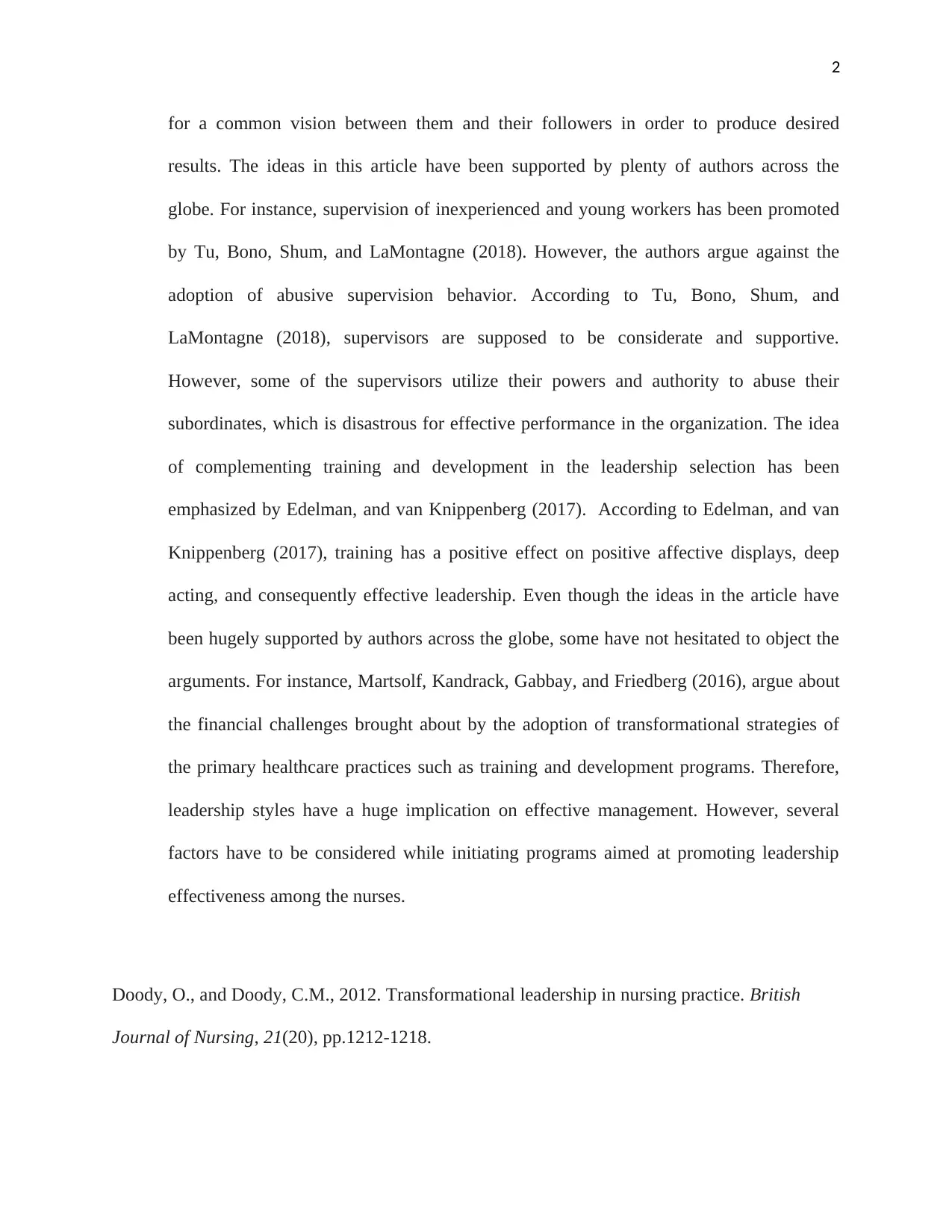
2
for a common vision between them and their followers in order to produce desired
results. The ideas in this article have been supported by plenty of authors across the
globe. For instance, supervision of inexperienced and young workers has been promoted
by Tu, Bono, Shum, and LaMontagne (2018). However, the authors argue against the
adoption of abusive supervision behavior. According to Tu, Bono, Shum, and
LaMontagne (2018), supervisors are supposed to be considerate and supportive.
However, some of the supervisors utilize their powers and authority to abuse their
subordinates, which is disastrous for effective performance in the organization. The idea
of complementing training and development in the leadership selection has been
emphasized by Edelman, and van Knippenberg (2017). According to Edelman, and van
Knippenberg (2017), training has a positive effect on positive affective displays, deep
acting, and consequently effective leadership. Even though the ideas in the article have
been hugely supported by authors across the globe, some have not hesitated to object the
arguments. For instance, Martsolf, Kandrack, Gabbay, and Friedberg (2016), argue about
the financial challenges brought about by the adoption of transformational strategies of
the primary healthcare practices such as training and development programs. Therefore,
leadership styles have a huge implication on effective management. However, several
factors have to be considered while initiating programs aimed at promoting leadership
effectiveness among the nurses.
Doody, O., and Doody, C.M., 2012. Transformational leadership in nursing practice. British
Journal of Nursing, 21(20), pp.1212-1218.
for a common vision between them and their followers in order to produce desired
results. The ideas in this article have been supported by plenty of authors across the
globe. For instance, supervision of inexperienced and young workers has been promoted
by Tu, Bono, Shum, and LaMontagne (2018). However, the authors argue against the
adoption of abusive supervision behavior. According to Tu, Bono, Shum, and
LaMontagne (2018), supervisors are supposed to be considerate and supportive.
However, some of the supervisors utilize their powers and authority to abuse their
subordinates, which is disastrous for effective performance in the organization. The idea
of complementing training and development in the leadership selection has been
emphasized by Edelman, and van Knippenberg (2017). According to Edelman, and van
Knippenberg (2017), training has a positive effect on positive affective displays, deep
acting, and consequently effective leadership. Even though the ideas in the article have
been hugely supported by authors across the globe, some have not hesitated to object the
arguments. For instance, Martsolf, Kandrack, Gabbay, and Friedberg (2016), argue about
the financial challenges brought about by the adoption of transformational strategies of
the primary healthcare practices such as training and development programs. Therefore,
leadership styles have a huge implication on effective management. However, several
factors have to be considered while initiating programs aimed at promoting leadership
effectiveness among the nurses.
Doody, O., and Doody, C.M., 2012. Transformational leadership in nursing practice. British
Journal of Nursing, 21(20), pp.1212-1218.
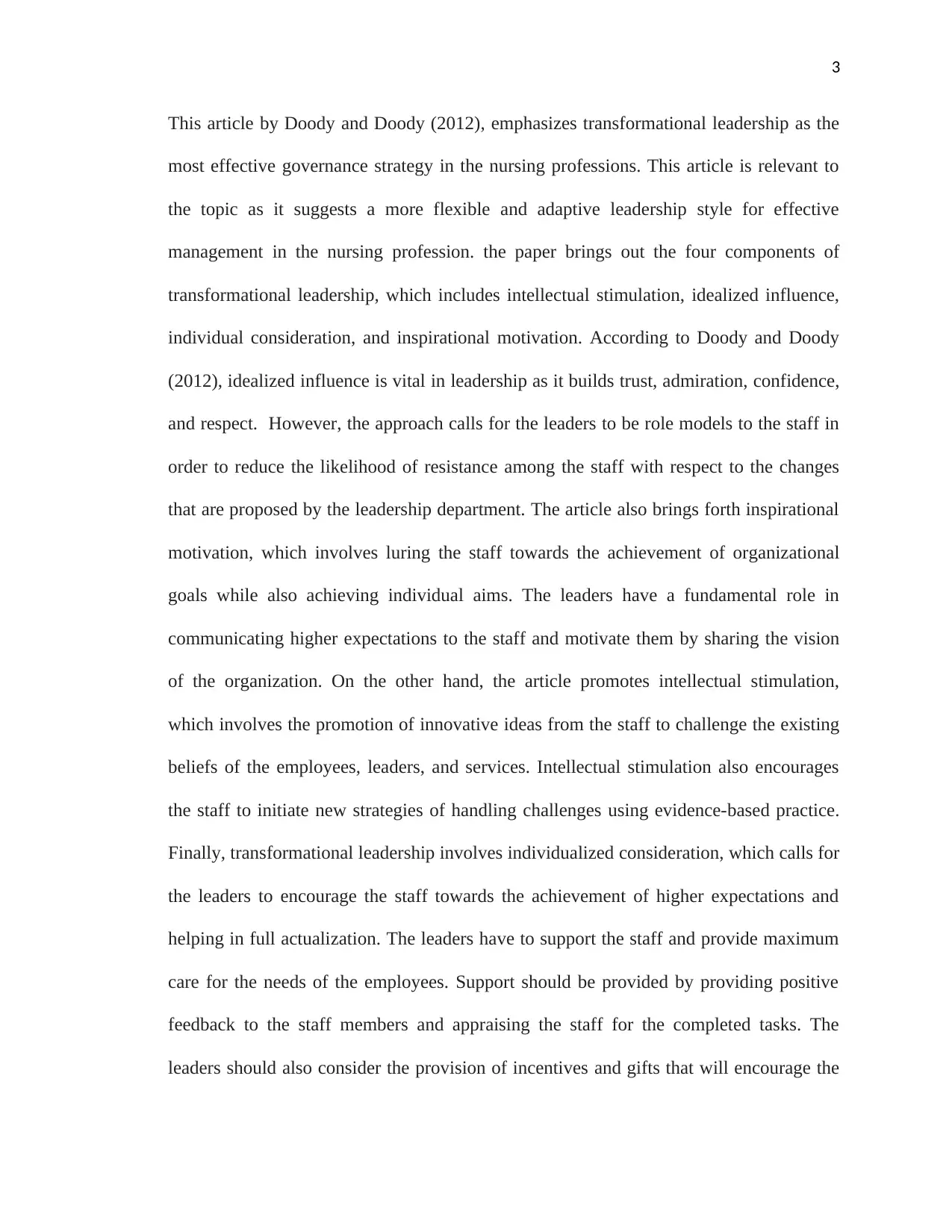
3
This article by Doody and Doody (2012), emphasizes transformational leadership as the
most effective governance strategy in the nursing professions. This article is relevant to
the topic as it suggests a more flexible and adaptive leadership style for effective
management in the nursing profession. the paper brings out the four components of
transformational leadership, which includes intellectual stimulation, idealized influence,
individual consideration, and inspirational motivation. According to Doody and Doody
(2012), idealized influence is vital in leadership as it builds trust, admiration, confidence,
and respect. However, the approach calls for the leaders to be role models to the staff in
order to reduce the likelihood of resistance among the staff with respect to the changes
that are proposed by the leadership department. The article also brings forth inspirational
motivation, which involves luring the staff towards the achievement of organizational
goals while also achieving individual aims. The leaders have a fundamental role in
communicating higher expectations to the staff and motivate them by sharing the vision
of the organization. On the other hand, the article promotes intellectual stimulation,
which involves the promotion of innovative ideas from the staff to challenge the existing
beliefs of the employees, leaders, and services. Intellectual stimulation also encourages
the staff to initiate new strategies of handling challenges using evidence-based practice.
Finally, transformational leadership involves individualized consideration, which calls for
the leaders to encourage the staff towards the achievement of higher expectations and
helping in full actualization. The leaders have to support the staff and provide maximum
care for the needs of the employees. Support should be provided by providing positive
feedback to the staff members and appraising the staff for the completed tasks. The
leaders should also consider the provision of incentives and gifts that will encourage the
This article by Doody and Doody (2012), emphasizes transformational leadership as the
most effective governance strategy in the nursing professions. This article is relevant to
the topic as it suggests a more flexible and adaptive leadership style for effective
management in the nursing profession. the paper brings out the four components of
transformational leadership, which includes intellectual stimulation, idealized influence,
individual consideration, and inspirational motivation. According to Doody and Doody
(2012), idealized influence is vital in leadership as it builds trust, admiration, confidence,
and respect. However, the approach calls for the leaders to be role models to the staff in
order to reduce the likelihood of resistance among the staff with respect to the changes
that are proposed by the leadership department. The article also brings forth inspirational
motivation, which involves luring the staff towards the achievement of organizational
goals while also achieving individual aims. The leaders have a fundamental role in
communicating higher expectations to the staff and motivate them by sharing the vision
of the organization. On the other hand, the article promotes intellectual stimulation,
which involves the promotion of innovative ideas from the staff to challenge the existing
beliefs of the employees, leaders, and services. Intellectual stimulation also encourages
the staff to initiate new strategies of handling challenges using evidence-based practice.
Finally, transformational leadership involves individualized consideration, which calls for
the leaders to encourage the staff towards the achievement of higher expectations and
helping in full actualization. The leaders have to support the staff and provide maximum
care for the needs of the employees. Support should be provided by providing positive
feedback to the staff members and appraising the staff for the completed tasks. The
leaders should also consider the provision of incentives and gifts that will encourage the
Secure Best Marks with AI Grader
Need help grading? Try our AI Grader for instant feedback on your assignments.
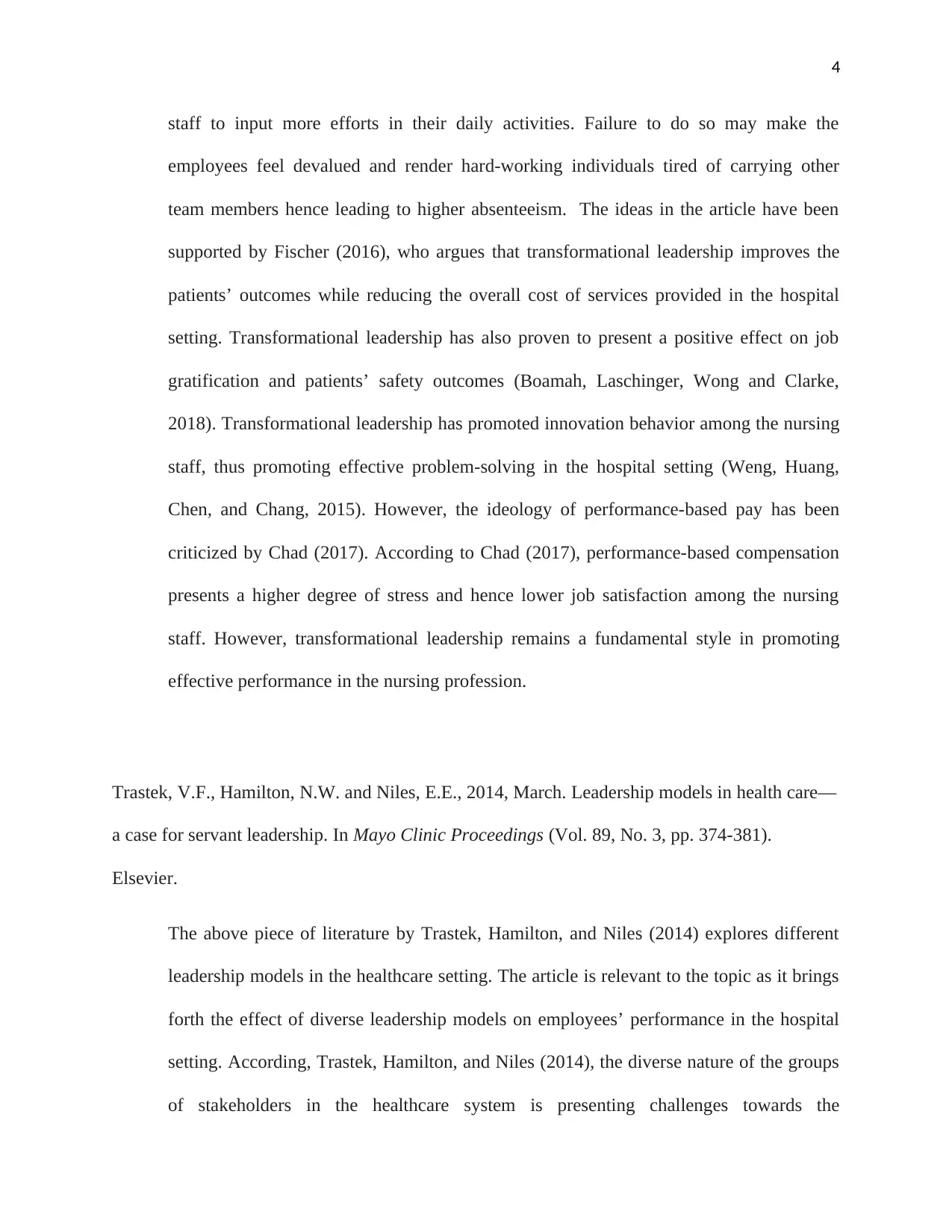
4
staff to input more efforts in their daily activities. Failure to do so may make the
employees feel devalued and render hard-working individuals tired of carrying other
team members hence leading to higher absenteeism. The ideas in the article have been
supported by Fischer (2016), who argues that transformational leadership improves the
patients’ outcomes while reducing the overall cost of services provided in the hospital
setting. Transformational leadership has also proven to present a positive effect on job
gratification and patients’ safety outcomes (Boamah, Laschinger, Wong and Clarke,
2018). Transformational leadership has promoted innovation behavior among the nursing
staff, thus promoting effective problem-solving in the hospital setting (Weng, Huang,
Chen, and Chang, 2015). However, the ideology of performance-based pay has been
criticized by Chad (2017). According to Chad (2017), performance-based compensation
presents a higher degree of stress and hence lower job satisfaction among the nursing
staff. However, transformational leadership remains a fundamental style in promoting
effective performance in the nursing profession.
Trastek, V.F., Hamilton, N.W. and Niles, E.E., 2014, March. Leadership models in health care—
a case for servant leadership. In Mayo Clinic Proceedings (Vol. 89, No. 3, pp. 374-381).
Elsevier.
The above piece of literature by Trastek, Hamilton, and Niles (2014) explores different
leadership models in the healthcare setting. The article is relevant to the topic as it brings
forth the effect of diverse leadership models on employees’ performance in the hospital
setting. According, Trastek, Hamilton, and Niles (2014), the diverse nature of the groups
of stakeholders in the healthcare system is presenting challenges towards the
staff to input more efforts in their daily activities. Failure to do so may make the
employees feel devalued and render hard-working individuals tired of carrying other
team members hence leading to higher absenteeism. The ideas in the article have been
supported by Fischer (2016), who argues that transformational leadership improves the
patients’ outcomes while reducing the overall cost of services provided in the hospital
setting. Transformational leadership has also proven to present a positive effect on job
gratification and patients’ safety outcomes (Boamah, Laschinger, Wong and Clarke,
2018). Transformational leadership has promoted innovation behavior among the nursing
staff, thus promoting effective problem-solving in the hospital setting (Weng, Huang,
Chen, and Chang, 2015). However, the ideology of performance-based pay has been
criticized by Chad (2017). According to Chad (2017), performance-based compensation
presents a higher degree of stress and hence lower job satisfaction among the nursing
staff. However, transformational leadership remains a fundamental style in promoting
effective performance in the nursing profession.
Trastek, V.F., Hamilton, N.W. and Niles, E.E., 2014, March. Leadership models in health care—
a case for servant leadership. In Mayo Clinic Proceedings (Vol. 89, No. 3, pp. 374-381).
Elsevier.
The above piece of literature by Trastek, Hamilton, and Niles (2014) explores different
leadership models in the healthcare setting. The article is relevant to the topic as it brings
forth the effect of diverse leadership models on employees’ performance in the hospital
setting. According, Trastek, Hamilton, and Niles (2014), the diverse nature of the groups
of stakeholders in the healthcare system is presenting challenges towards the
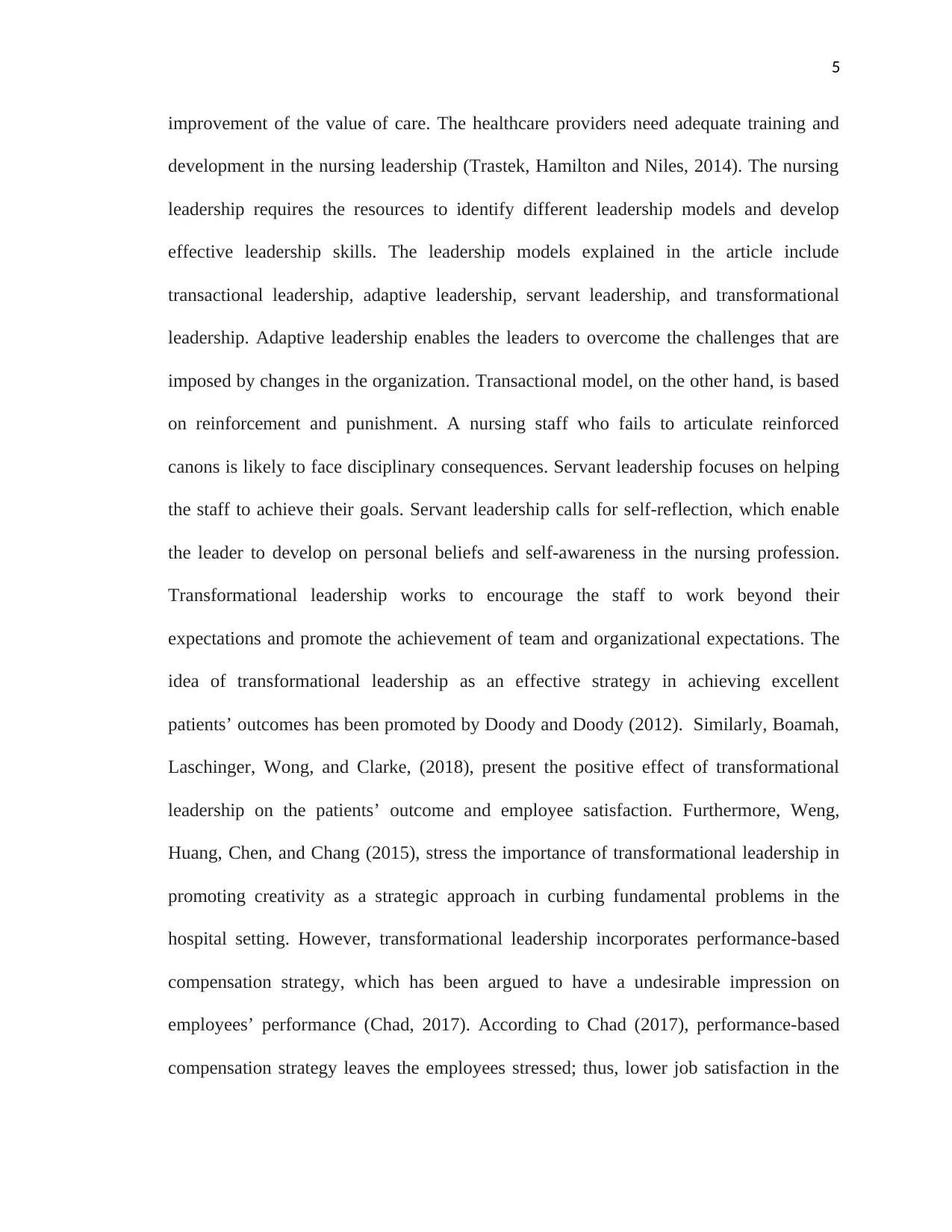
5
improvement of the value of care. The healthcare providers need adequate training and
development in the nursing leadership (Trastek, Hamilton and Niles, 2014). The nursing
leadership requires the resources to identify different leadership models and develop
effective leadership skills. The leadership models explained in the article include
transactional leadership, adaptive leadership, servant leadership, and transformational
leadership. Adaptive leadership enables the leaders to overcome the challenges that are
imposed by changes in the organization. Transactional model, on the other hand, is based
on reinforcement and punishment. A nursing staff who fails to articulate reinforced
canons is likely to face disciplinary consequences. Servant leadership focuses on helping
the staff to achieve their goals. Servant leadership calls for self-reflection, which enable
the leader to develop on personal beliefs and self-awareness in the nursing profession.
Transformational leadership works to encourage the staff to work beyond their
expectations and promote the achievement of team and organizational expectations. The
idea of transformational leadership as an effective strategy in achieving excellent
patients’ outcomes has been promoted by Doody and Doody (2012). Similarly, Boamah,
Laschinger, Wong, and Clarke, (2018), present the positive effect of transformational
leadership on the patients’ outcome and employee satisfaction. Furthermore, Weng,
Huang, Chen, and Chang (2015), stress the importance of transformational leadership in
promoting creativity as a strategic approach in curbing fundamental problems in the
hospital setting. However, transformational leadership incorporates performance-based
compensation strategy, which has been argued to have a undesirable impression on
employees’ performance (Chad, 2017). According to Chad (2017), performance-based
compensation strategy leaves the employees stressed; thus, lower job satisfaction in the
improvement of the value of care. The healthcare providers need adequate training and
development in the nursing leadership (Trastek, Hamilton and Niles, 2014). The nursing
leadership requires the resources to identify different leadership models and develop
effective leadership skills. The leadership models explained in the article include
transactional leadership, adaptive leadership, servant leadership, and transformational
leadership. Adaptive leadership enables the leaders to overcome the challenges that are
imposed by changes in the organization. Transactional model, on the other hand, is based
on reinforcement and punishment. A nursing staff who fails to articulate reinforced
canons is likely to face disciplinary consequences. Servant leadership focuses on helping
the staff to achieve their goals. Servant leadership calls for self-reflection, which enable
the leader to develop on personal beliefs and self-awareness in the nursing profession.
Transformational leadership works to encourage the staff to work beyond their
expectations and promote the achievement of team and organizational expectations. The
idea of transformational leadership as an effective strategy in achieving excellent
patients’ outcomes has been promoted by Doody and Doody (2012). Similarly, Boamah,
Laschinger, Wong, and Clarke, (2018), present the positive effect of transformational
leadership on the patients’ outcome and employee satisfaction. Furthermore, Weng,
Huang, Chen, and Chang (2015), stress the importance of transformational leadership in
promoting creativity as a strategic approach in curbing fundamental problems in the
hospital setting. However, transformational leadership incorporates performance-based
compensation strategy, which has been argued to have a undesirable impression on
employees’ performance (Chad, 2017). According to Chad (2017), performance-based
compensation strategy leaves the employees stressed; thus, lower job satisfaction in the
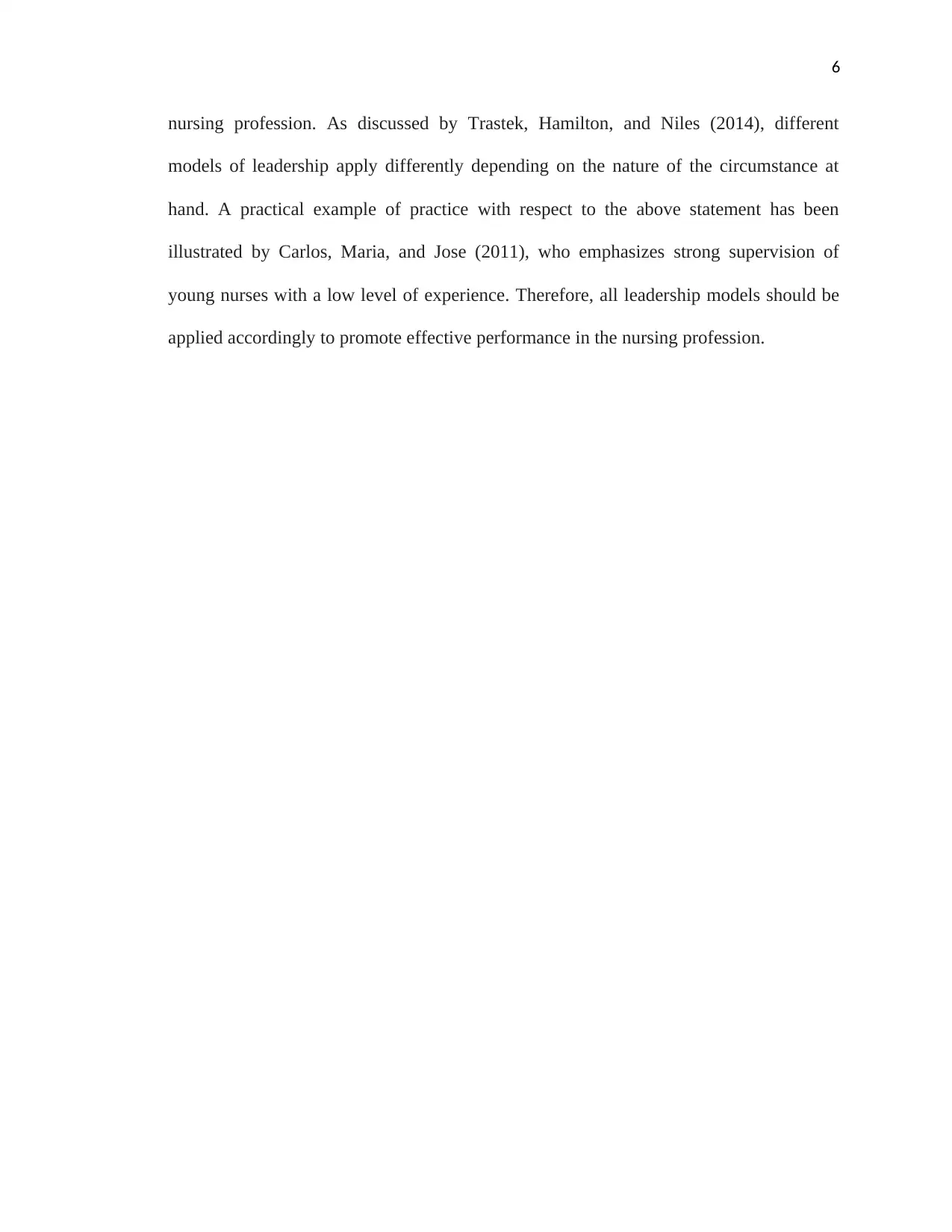
6
nursing profession. As discussed by Trastek, Hamilton, and Niles (2014), different
models of leadership apply differently depending on the nature of the circumstance at
hand. A practical example of practice with respect to the above statement has been
illustrated by Carlos, Maria, and Jose (2011), who emphasizes strong supervision of
young nurses with a low level of experience. Therefore, all leadership models should be
applied accordingly to promote effective performance in the nursing profession.
nursing profession. As discussed by Trastek, Hamilton, and Niles (2014), different
models of leadership apply differently depending on the nature of the circumstance at
hand. A practical example of practice with respect to the above statement has been
illustrated by Carlos, Maria, and Jose (2011), who emphasizes strong supervision of
young nurses with a low level of experience. Therefore, all leadership models should be
applied accordingly to promote effective performance in the nursing profession.
Paraphrase This Document
Need a fresh take? Get an instant paraphrase of this document with our AI Paraphraser
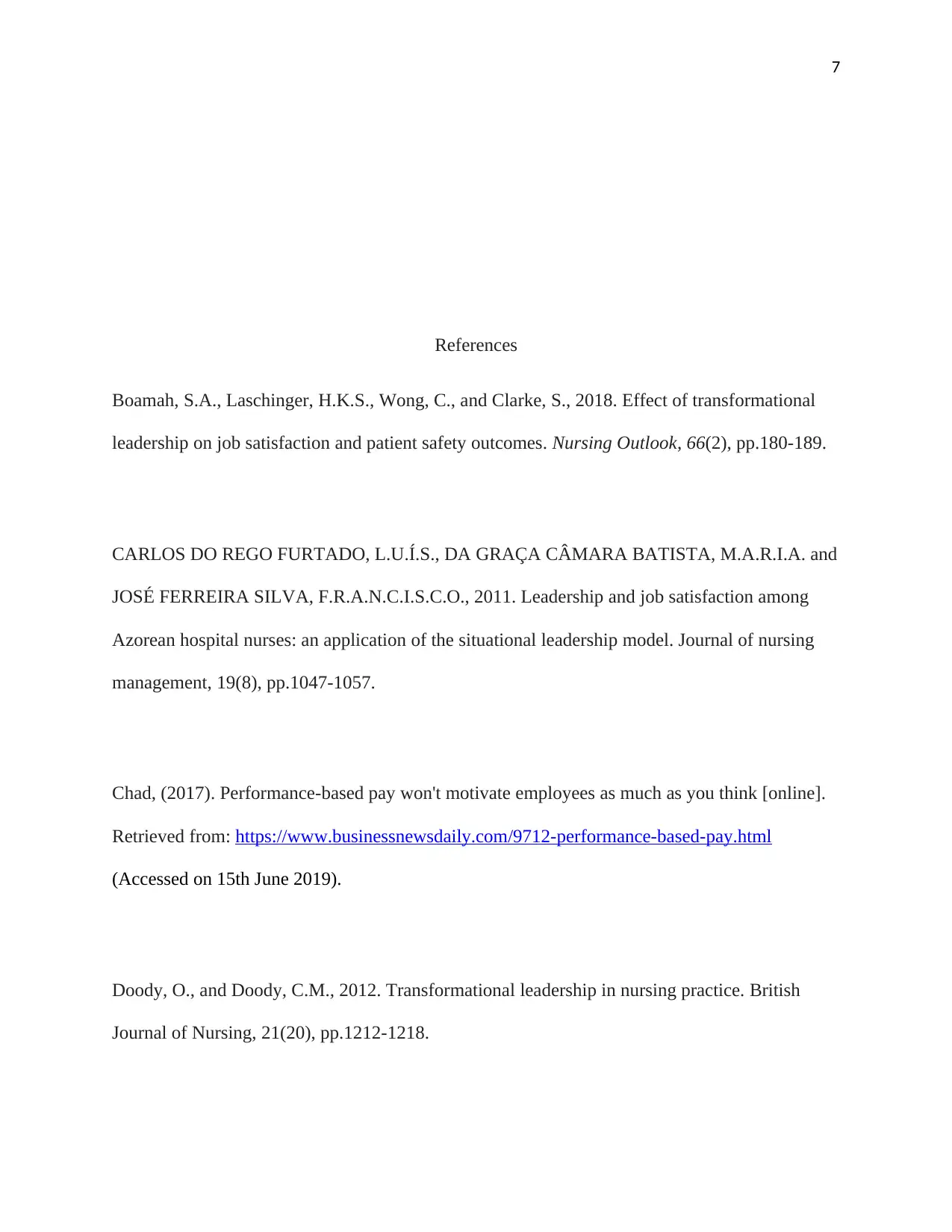
7
References
Boamah, S.A., Laschinger, H.K.S., Wong, C., and Clarke, S., 2018. Effect of transformational
leadership on job satisfaction and patient safety outcomes. Nursing Outlook, 66(2), pp.180-189.
CARLOS DO REGO FURTADO, L.U.Í.S., DA GRAÇA CÂMARA BATISTA, M.A.R.I.A. and
JOSÉ FERREIRA SILVA, F.R.A.N.C.I.S.C.O., 2011. Leadership and job satisfaction among
Azorean hospital nurses: an application of the situational leadership model. Journal of nursing
management, 19(8), pp.1047-1057.
Chad, (2017). Performance-based pay won't motivate employees as much as you think [online].
Retrieved from: https://www.businessnewsdaily.com/9712-performance-based-pay.html
(Accessed on 15th June 2019).
Doody, O., and Doody, C.M., 2012. Transformational leadership in nursing practice. British
Journal of Nursing, 21(20), pp.1212-1218.
References
Boamah, S.A., Laschinger, H.K.S., Wong, C., and Clarke, S., 2018. Effect of transformational
leadership on job satisfaction and patient safety outcomes. Nursing Outlook, 66(2), pp.180-189.
CARLOS DO REGO FURTADO, L.U.Í.S., DA GRAÇA CÂMARA BATISTA, M.A.R.I.A. and
JOSÉ FERREIRA SILVA, F.R.A.N.C.I.S.C.O., 2011. Leadership and job satisfaction among
Azorean hospital nurses: an application of the situational leadership model. Journal of nursing
management, 19(8), pp.1047-1057.
Chad, (2017). Performance-based pay won't motivate employees as much as you think [online].
Retrieved from: https://www.businessnewsdaily.com/9712-performance-based-pay.html
(Accessed on 15th June 2019).
Doody, O., and Doody, C.M., 2012. Transformational leadership in nursing practice. British
Journal of Nursing, 21(20), pp.1212-1218.
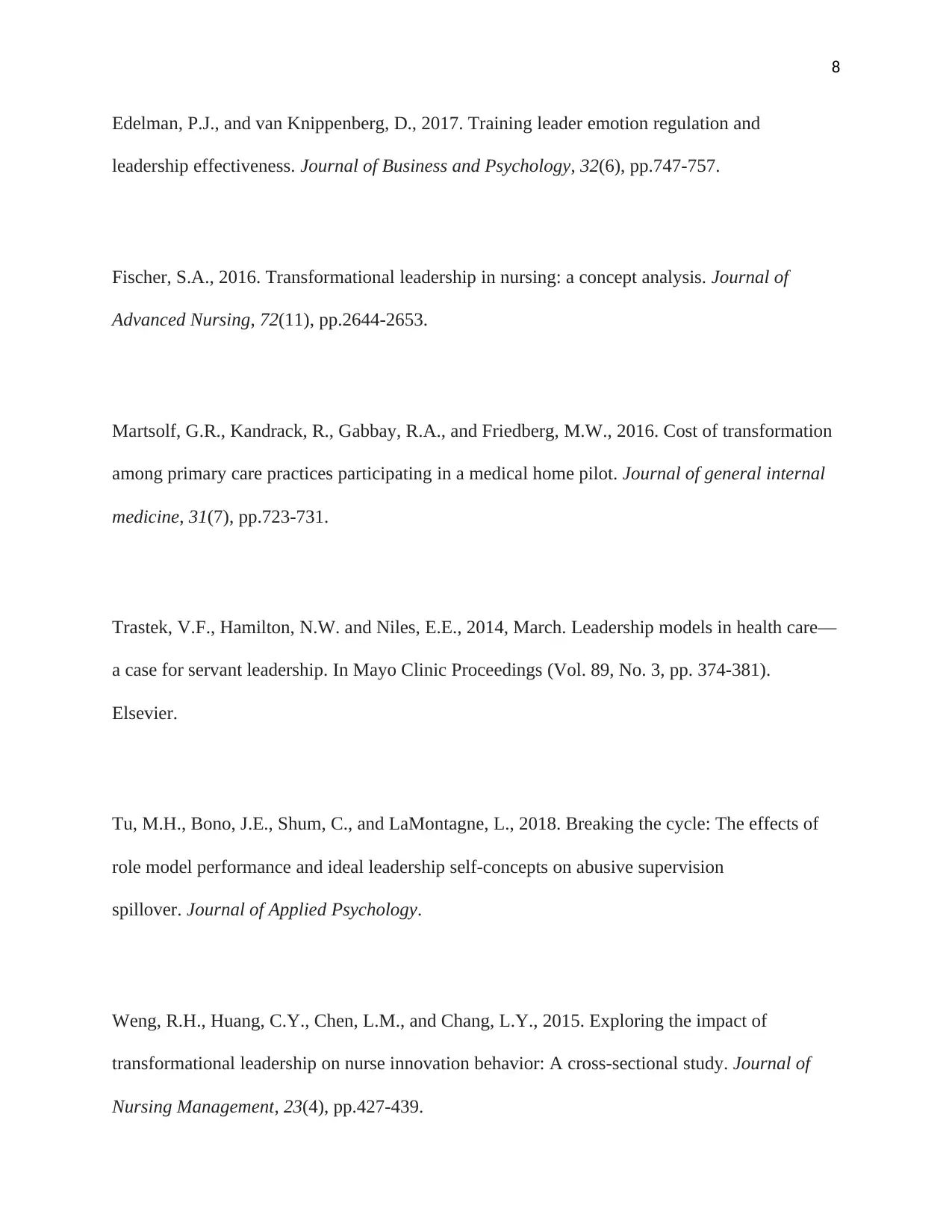
8
Edelman, P.J., and van Knippenberg, D., 2017. Training leader emotion regulation and
leadership effectiveness. Journal of Business and Psychology, 32(6), pp.747-757.
Fischer, S.A., 2016. Transformational leadership in nursing: a concept analysis. Journal of
Advanced Nursing, 72(11), pp.2644-2653.
Martsolf, G.R., Kandrack, R., Gabbay, R.A., and Friedberg, M.W., 2016. Cost of transformation
among primary care practices participating in a medical home pilot. Journal of general internal
medicine, 31(7), pp.723-731.
Trastek, V.F., Hamilton, N.W. and Niles, E.E., 2014, March. Leadership models in health care—
a case for servant leadership. In Mayo Clinic Proceedings (Vol. 89, No. 3, pp. 374-381).
Elsevier.
Tu, M.H., Bono, J.E., Shum, C., and LaMontagne, L., 2018. Breaking the cycle: The effects of
role model performance and ideal leadership self-concepts on abusive supervision
spillover. Journal of Applied Psychology.
Weng, R.H., Huang, C.Y., Chen, L.M., and Chang, L.Y., 2015. Exploring the impact of
transformational leadership on nurse innovation behavior: A cross‐sectional study. Journal of
Nursing Management, 23(4), pp.427-439.
Edelman, P.J., and van Knippenberg, D., 2017. Training leader emotion regulation and
leadership effectiveness. Journal of Business and Psychology, 32(6), pp.747-757.
Fischer, S.A., 2016. Transformational leadership in nursing: a concept analysis. Journal of
Advanced Nursing, 72(11), pp.2644-2653.
Martsolf, G.R., Kandrack, R., Gabbay, R.A., and Friedberg, M.W., 2016. Cost of transformation
among primary care practices participating in a medical home pilot. Journal of general internal
medicine, 31(7), pp.723-731.
Trastek, V.F., Hamilton, N.W. and Niles, E.E., 2014, March. Leadership models in health care—
a case for servant leadership. In Mayo Clinic Proceedings (Vol. 89, No. 3, pp. 374-381).
Elsevier.
Tu, M.H., Bono, J.E., Shum, C., and LaMontagne, L., 2018. Breaking the cycle: The effects of
role model performance and ideal leadership self-concepts on abusive supervision
spillover. Journal of Applied Psychology.
Weng, R.H., Huang, C.Y., Chen, L.M., and Chang, L.Y., 2015. Exploring the impact of
transformational leadership on nurse innovation behavior: A cross‐sectional study. Journal of
Nursing Management, 23(4), pp.427-439.
1 out of 9
Your All-in-One AI-Powered Toolkit for Academic Success.
+13062052269
info@desklib.com
Available 24*7 on WhatsApp / Email
![[object Object]](/_next/static/media/star-bottom.7253800d.svg)
Unlock your academic potential
© 2024 | Zucol Services PVT LTD | All rights reserved.